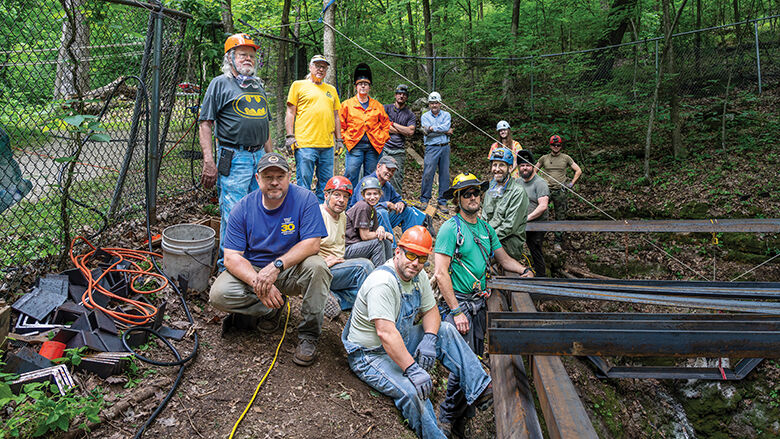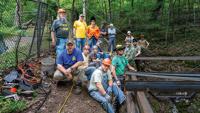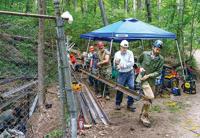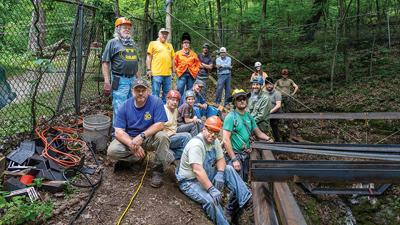A group of experts is finishing up a yearslong project to protect and preserve what could be the longest cave in Jefferson County.
Tony Schmitt, president of Missouri Caves and Karst Conservancy, said the cave inside the Pleasant Valley Nature Preserve in High Ridge has not been properly cared for in past years, and vital local wildlife, like bats and salamanders, have fled the area due to the destruction of their natural cave habitat.
The Jefferson County Council gave MCKC officials permission to restore and manage the cave at Pleasant Valley Nature Preserve, 6701 Twin River Road, in 2023. The agreement allows MCKC to care for the cave on the 40-acre preserve at no cost to the county.
Since then, the nonprofit organization, along with members from the local caving club, Meramec Valley Grotto, has raised $26,000 to construct a gate over the mouth of the cave. The “bat gate,” as Schmitt calls it, allows bats to easily fly in and out of the cave but blocks trespassers from entering, dumping trash there and vandalizing the cave.
Before the gate was built, the club hauled tons of trash out of the cave and cleaned the cave walls of decades’ worth of spray paint and other signs of vandalism.
The nature preserve was closed to the public from May 23 to June 2 while caving crews worked to install the gate.
The Meramec Valley Grotto group that’s helping to preserve the cave is an “eclectic group” of about 35 nature lovers, Schmitt said, including a doctor, photojournalist, retired electrical engineer, retired Department of Natural Resources employee, pawn shop owner, college student, union sheet metal worker and fireman.
“We’re providing responsible access and responsibly managing the cave for the health of the inside,” said Schmitt, 50, of the Jefferson County portion of Fenton. “A lot of people don’t like gates, and honestly, I don’t really like them either. Gates like this should be the absolute last management plan. It’s unfortunate; it does take away from the scenic value of the entrance. But more importantly, we’re protecting everything inside the cave.”
Councilman Billy Crow (District 3, Arnold) said one of his co-workers, Alicia Wallace, is part of the group working on the cave project.
“Sometimes in these sorts of situations, you get volunteers who don’t know what they’re doing,” he said. “But what’s really cool is one of my fellow sheet metal workers, Alicia Wallace, will be there as a trained union welder, helping construct (the gate). Other trained construction workers will also be partaking in this. They know what they’re doing, and they’re doing a great job. I’m really excited that someone I know is helping the county.”

About 35 members of the Meramec Valley Grotto group are working to preserve the cave.
Environment
Schmitt, a 1992 Northwest High School graduate, remembers the virtually lawless time of cave exploration during his youth when students held parties in the cave. Then, during his senior year of high school, the county Parks and Recreation Department decided to seal the cave entrance with concrete and place a gate in front of the cave mouth.
The measure was mostly effective in keeping trespassers out, but it also entombed the living creatures inside the cave, he said.
Schmitt estimated that the cave used to be home to about 20,000 bats, and now, there are no signs of bats living there.
With MCKC managing the cave, Schmitt said, only a limited number of people will have access to the cave, and hopefully, wildlife will return. The people with access will need to gain permission from MCKC and follow all caving practices, which may be summed up with the phrase, “taking nothing but a picture, killing nothing but time, leaving nothing but footprints.”
A kiosk with information about the cave and how to contact MCKC will be installed near the cave entrance, he said.
“The cave is being opened up to allow airflow and responsible access, but it’s not going to be a tour cave,” Schmitt said. “It’s responsible access for people who are vetted, who are qualified to go in there.”

The original gate to the cave at Pleasant Valley Nature Preserve in High Ridge was installed in 1992.
Mapping
When it was last surveyed in the 1960s, the Pleasant Valley Cave was estimated to be about 1 mile long, Schmitt said, adding that the cave entrance drops down about 30 feet into a pit before branching into a multilevel passage that follows a stream.
Once the local caving club clears all the debris people have left behind in the cave, the group will begin thoroughly remapping the cave, Schmitt said.
“This cave, once we start resurveying, will probably be the longest cave in the county,” he said. “It’ll be over a mile, is my prediction. The old map didn’t get a lot of what was in there. You know, you got to think about the 1960s; those guys were using carbide lamps, with jean jackets and Manila rope. Our equipment now is space-age compared to theirs.”
MCKC was founded in 1992 as a land trust, Schmitt said, and owns, manages or leases caves across the state. The nonprofit currently has 11 properties under its care. MCKC members, along with members of the Missouri Speleological Survey, work to maintain records about the state’s caves and their locations.
Dan Lamper, 45, of Otto has been the president of MSS for 10 years. He said the organization, founded in 1956, is approaching 8,000 documented caves in Missouri, adding about 100 new caves annually to the record.
When he’s not mapping Missouri’s caves, Lamper works as a social studies teacher at Mehlville High School.
“We want knowledge of caves, awareness of caves, resources, sensitivity, and life to be documented to help us to be able to protect it, but also we try to put a lot of that data into the hands of people who are empowered to make policy decisions,” he said. “For example, we have an agreement with the Missouri Department of Transportation, so when they’re building new highways, before even laying out where the highway is going to be, they’re looking to see if there are known caves.”
Schmitt said attending Meramec Valley Grotto meetings is a good, responsible entry point into local caving. The group meets at 6 p.m. on the second Tuesday of every month at the Powder Valley Conservation Nature Center in Kirkwood, 11715 Cragwold Road.
For more information about MCKC, visit its website, mocavesandkarst.org.
“The best result would be that this (cave restoration project) becomes an educational resource,” Schmitt said. “We have lots of people who live on caves and karsts (landscapes where dissolving bedrock has created sinkholes, caves, springs and other similar features), and most of them don’t understand what they’re living on or how it works. We would love this to be the place where people can come and read the kiosk if they’re interested in learning how to go caving.
“There are always avenues to do this; you just have to get with the right group to do it.”









